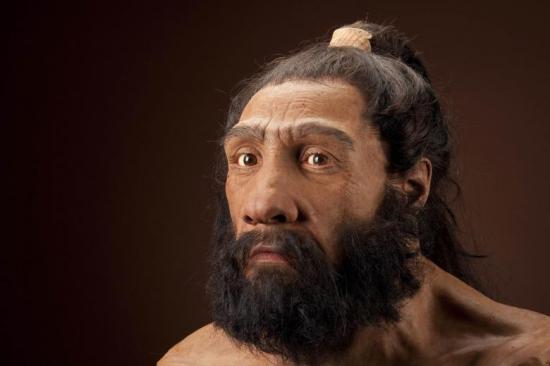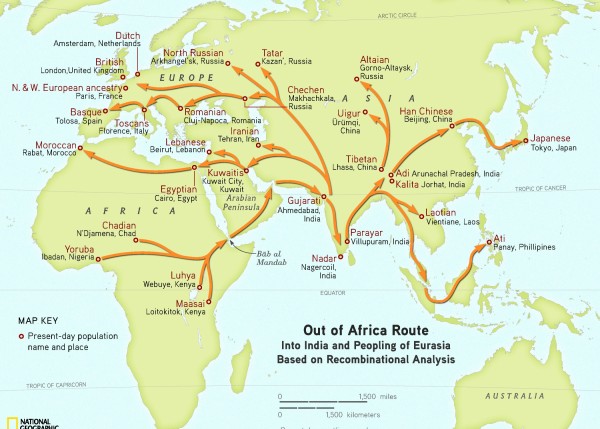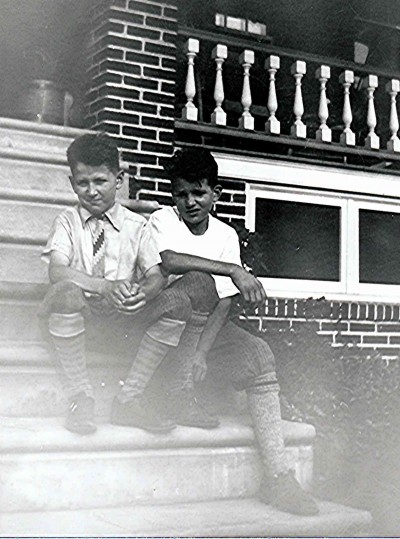On Christmas Day of 2012 I unwrapped a present that was really a time machine – two small sealed tubes holding swabs I was to use to scrape the inside of my mouth and documents that described how I was about to become a part of scientific information gathering on a world-wide scale. Scrape, seal, mail to National Geographic, and five months later my genetic history, and by extension, the genetic history of my family, would be revealed to me. We knew that the Wall’s and O’Donnell’s, Bankey’s and Quigley’s hailed from Ireland and Germany, but the depth of the genetic results I’ve received reveals a history greater in geographic sweep and time than I had anticipated.
 Contemporary artist’s rendering of a Neanderthal
Contemporary artist’s rendering of a Neanderthal
My DNA, because I am male, contains the inheritance of both my mother and father. My brother, sisters and I possess a genetic code crowded with ancestors who mix 43% northern European, 38% Mediterranean and 19% southwest Asian biographical and geographic markers. Within that 100%, we have the remnants of both Neanderthals and Denisovans to the tune of 4%. We carry the blood tags of two continents, a sub-continent, two islands and two extinct human species.
All paternal lines of descent for all human beings trace back 140,000 years; all maternal lines go back to 180,000 years. Both originated in East Africa; our family’s direct paternal line begins 22,000 years ago somewhere along the Mediterranean. Our direct maternal line begins between 60,000 and 70,000 years ago in roughly the same area.
Our skins were once dark. We once looked up at star fields dominated by the Southern Cross, not the Big Dipper.
An imaginative leap into this trace is inescapable. What did it feel like for those whose blood and genes we carry now to live in this old world?
In their migrations they followed game herds. Our people were hunter-gatherers, dressed in animal skins (when they wore anything at all). Farming as we would recognize it did not begin until about 8500 BCE. Therefore they hunted and experimented in eating roots, nuts, berries, flowers, barks and plants. They learned how to cooperate and mesh child-rearing and individual skills.
They bred with other groups met in long forgotten valleys. We were predators and prey; only “about 25% of adult humans survived past 40.” * When I pause, I think about all those myriad blood-lines snuffed out by animals, disease, storms, rivers swollen with flood waters, other tribes waiting in ambush. Our genetic strain slipped through enough microscopic breaks of luck to make it to the present day.
For centuries at a time they moved only a few miles a year; they changed shape and color by breeding and blending with others. They must have tried on new cultures like suits. How many gods did they embrace? When did they add fire to their survival skills? What languages, long since extinct, did they speak? What stories did they tell each other?
Our ancestors crossed a green, wet Sahara, and rose up the Nile basin to the sea. They roamed both east and west along the African coast of the Mediterranean, picking up genetic markers from present day Tunisia, Egypt, and Lebanon. The evidence suggests that we might have picked up our Neanderthal and Denisovan traits about 60,000 years ago (I have taught students who would not be surprised by this) somewhere along the sea’s eastern curve – present day Israel perhaps.

One of many Genomic Migratory Maps
Our ancestors struck north both through Turkey and into the Balkans, and during the millennia it took for this portion of the journey, markers from India, Iran and Tajikistan bled into our DNA; my mother’s line seems to have brought in the southwest Asian influence, but also, one of her genetic hot spots, a place where a large portion of the population retains genetic markers that align with hers, is in Saudi Arabia. Some of her people followed a route similar to my father’s – this share of our ancestors took a route on the far side of the Black Sea, hugging the Caspian, and thus through Georgia, the Caucasus and southern Russia and then west. If we had the means my mother’s line would likely trace its origins back to Russia.
Our second strongest genetic indicator can be found in present day Romania. I would not have believed this. Romanian. However,  a hot spot on the map indicates a very strong Greek influence on my father’s side. The marker labeled Romanian covers this area. Combine that with my mother’s history from India and perhaps we have Roma in us, Gypsy eyes and smiles. Perhaps it is the Greek that we see in pictures of my father as a boy. My brother may also have similar strong physical traits.# If we had the means my father’s line would likely trace its origin back to the Balkans.
a hot spot on the map indicates a very strong Greek influence on my father’s side. The marker labeled Romanian covers this area. Combine that with my mother’s history from India and perhaps we have Roma in us, Gypsy eyes and smiles. Perhaps it is the Greek that we see in pictures of my father as a boy. My brother may also have similar strong physical traits.# If we had the means my father’s line would likely trace its origin back to the Balkans.
The brawler on the right is my father.
Imagine a dozen needles, each carrying genetic material, all converging to contribute its thread to the larger warp and weft of our heredity – my God, we also contain bits of Italian, Spanish and Sardinian peoples.
All this time, hunger drove them, their pursuit of meat and hides, and escapes from stronger clans, and one imagines that curiosity too pushed forward at least a few of them. Bruce Chatwin poses the theory that “…our need for distraction, our mania for the new, was, in essence, an instinctive migratory urge akin to that of birds in autumn (161).” **
What lay to the north and west? Completely in tune with the natural world, we would have watched the migratory patterns of birds and wondered about their destinations. We would have listened to stories from others about lands with good water and large game herds and sheltering valleys for a winter’s rest. It logically develops that some would have followed the threads of those stories north and west, always north and west.
Both sides of the family made it to Europe about 10 to 15,000 BCE. They might have followed the retreating glaciers of the last ice age into Finland and Germany, across to Denmark, down through France and thence to our strongest genetic indicator, a British marker, and then into Northern Ireland, home at last, and by all the genetic signs, we were among the earliest settlers in these places. A critical statistic: 61% of the current Irish population contains genetic markers that match our mother’s. However, one strain of her family, the one that produced her maternal line, remained in what looks to be present day Austria where one of her hot spots shows itself. This corresponds with what we know of her maternal grandfather, who came to this country from Germany.
The Walls and O’Donnell’s had begun as Africans and evolved into Celts, and were huddling around peat fires in green lands when Egyptian civilization began to build their monuments.
All of us are products of ancestral runs of preposterous luck, dramatic shows of courage and immune systems made tough by natural selection. The four of us, brothers and sisters, have no more purity of lineage in us than any other human being. All of us are a brew of untold thousands, probably tens of thousands of couples who found their way through swirling cauldrons of clashing, competing, trading, warring, and breeding populations. We are all lucky mutts, everyone who reads this, everyone out there whose people once lived in yurts, huts, clochans, mitatos, cabins and caves.
^^ A Post about ancient human beings — well, anything that lets me pull Mel Brooks’ “2000 year old man” into a Post makes for a happy day.
* “Life span of Early Man Same as Neanderthals’” by Sindya Bhanoo; New York Times, January 10, 2011
# The Roma or Gypsies were migrants from the Indian sub-continent.
** The Songlines by Bruce Chatwin
how wonderful, Mike. This should keep your mind working for a while!!
Because my Grandmother’s people were greek Jasmine) we may even be relatives!